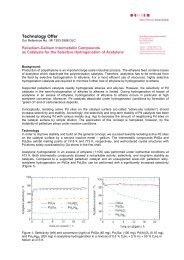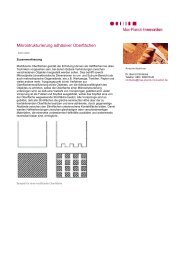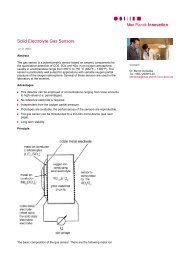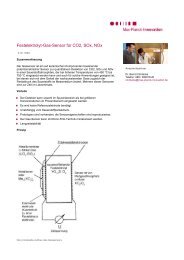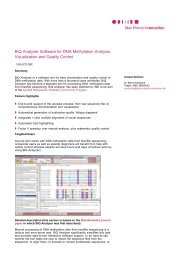FHI-aims - All-Electron Ab initio Molecular Simulation - Max-Planck ...
FHI-aims - All-Electron Ab initio Molecular Simulation - Max-Planck ...
FHI-aims - All-Electron Ab initio Molecular Simulation - Max-Planck ...
You also want an ePaper? Increase the reach of your titles
YUMPU automatically turns print PDFs into web optimized ePapers that Google loves.
Software<br />
<strong>FHI</strong>-<strong>aims</strong><br />
<strong>All</strong>-<strong>Electron</strong> <strong>Ab</strong> <strong>initio</strong> <strong>Molecular</strong> <strong>Simulation</strong> of<br />
Condensed Matter and Materials<br />
0302-3855 GBC<br />
<strong>FHI</strong>-<strong>aims</strong> is an efficient computer program package to calculate physical and<br />
chemical properties of condensed matter and materials (such as molecules,<br />
clusters, solids, liquids) based on a first-principles description of the<br />
electronic structure.<br />
The primary production method is density functional theory. The package is<br />
also a flexible framework for advanced approaches to calculate ground- and<br />
excited-state properties, current developments including hybrid functionals,<br />
MP2, GW, and QM/MM techniques.<br />
<strong>FHI</strong>-<strong>aims</strong> uses numeric atom-centered orbitals as the quantum-mechanical<br />
basis set. This enables accurate all-electron/ full-potential calculations at a<br />
computational cost which is competitive with, for instance, plane wave<br />
methods, without invoking a priori approximations to the potential (such as<br />
pseudopotentials, frozen cores).<br />
Current functionalities include:<br />
Density functional theory (LDA and GGA, including spin-polarization)<br />
Cluster and periodic geometries on equal footing<br />
Preconstructed, hierarchical ground state basis sets up to meV total<br />
energy accuracy<br />
Scalar relativity (scaled ZORA)<br />
1st- or 2nd-order geometry relaxation (BFGS) from analytical interatomic<br />
forces<br />
Embedding into classical electrostatic monopolar/ dipolar fields<br />
Hybrid functionals and Hartree-Fock+MP2 total energies (clusters)<br />
Post-DFT electronic quasiparticle excitation energies based on GW and<br />
MP2 self-energies (clusters)<br />
Technical information:<br />
Fully parallel treatment (MPI) using the same code base as the serial<br />
version – near-ideal scaling for large systems up to hundreds of CPU’s<br />
Parallelization for massively parallel computing platforms (IBM Blue Gene)<br />
Simple, transparent input/ output handling: file based input, no more than<br />
two required input files; file based output with complete information in a<br />
single, self-explanatory file<br />
Fortran95 code with evolving modularity<br />
Tested operating systems include Linux (32-/64-bit), Unix (Tru64,AIX),<br />
MacOS X<br />
Use of flexible, decentralized source code management tools<br />
Ansprechpartner<br />
Dr. Bernd Ctortecka<br />
Telefon: 089 / 290919-20<br />
ctortecka@max-planck-innovation.de
Publications on <strong>FHI</strong>-<strong>aims</strong><br />
in preparation<br />
Price List for <strong>FHI</strong>-<strong>aims</strong><br />
License (*) for Academic institutions (up to 5<br />
user)<br />
License (*) for Academic institutions (up to 20<br />
user)<br />
Commercial license – use of <strong>FHI</strong>-<strong>aims</strong> in a<br />
non-academic setting, such as in companies.<br />
€ 2.000,--<br />
€ 4.000,--<br />
Please contact Matthias<br />
Scheffler directly.<br />
(*) includes executable software and the source code; copies only to be used within the<br />
registered group and for backup purposes.<br />
Academic institutions are universities, non-profit research laboratories, and schools.<br />
<strong>FHI</strong>-<strong>aims</strong> is developed at the Theory Department of the Fritz Haber Institute<br />
in Berlin. For detailed information see the <strong>FHI</strong>-<strong>aims</strong> website. For technical<br />
and scientific questions, or if you like to obtain a demonstration version,<br />
please contact one of the lead developers, Volker Blum and Matthias<br />
Scheffler.



